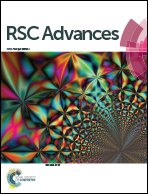Electrodeposition and characterization of Ni–SiC composite coatings from deep eutectic solvent
Abstract
In this paper, a choline chloride (ChCl)/ethylene glycol (EG) based deep eutectic solvent (DES) without any stabilizing additives was used as electrolyte to electrodeposit Ni matrix composite coatings containing either micro or nano-sized SiC particles. The electrochemical behavior of Ni in the presence of micro or nano-sized SiC particles was investigated. The effects of particle concentration, current density and stirring rate on the content of micro or nano-sized SiC particles incorporated into the Ni matrix were investigated. The microstructure, microhardness and tribological property of pure Ni and Ni matrix composite coatings containing micro or nano-sized SiC particles were compared. Results showed that the addition of micro or nano-sized SiC particles have significant effects on the nucleation mechanism of Ni in ChCl/EG DES. Micro and nano-sized SiC particles uniformly incorporated into the composite coatings, the content of SiC particles embedded in Ni coatings depends on the deposition parameters and particle size, and the maximum content of SiC in composite coatings can achieve 12.80 wt% and 5.37 wt%, respectively. Compared with the pure Ni coating, the microhardness and wear resistance of Ni–SiC composite coatings are significantly improved and the Ni matrix composite coatings containing nano-sized SiC particles exhibited better tribological property than that containing the micro-sized SiC particles.


 Please wait while we load your content...
Please wait while we load your content...